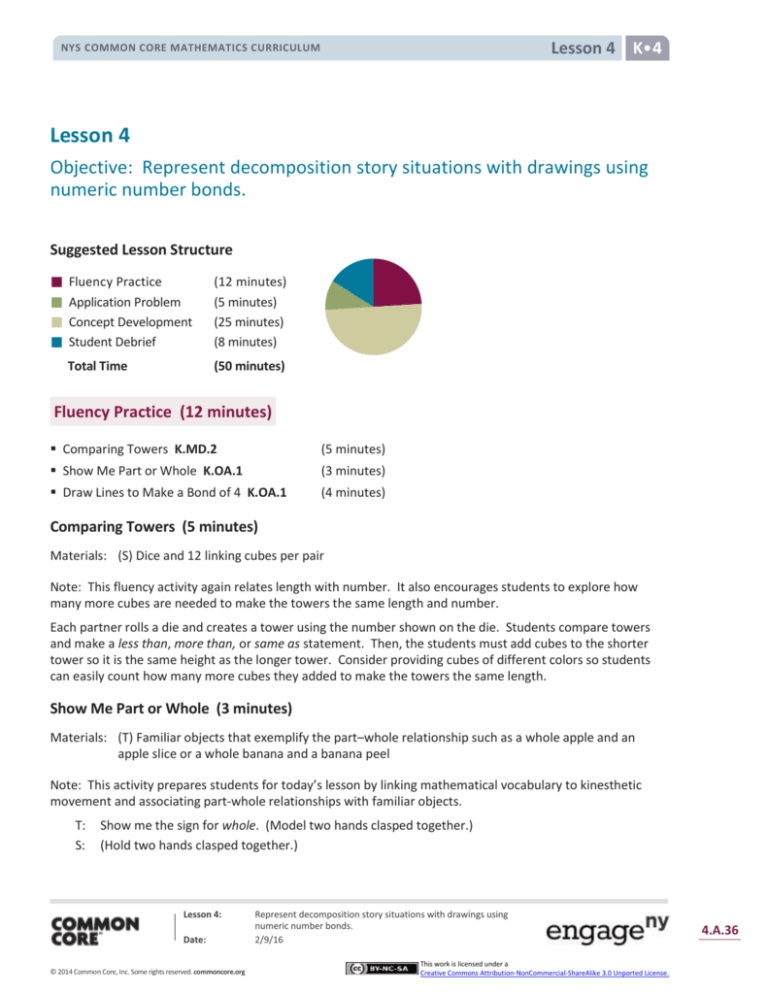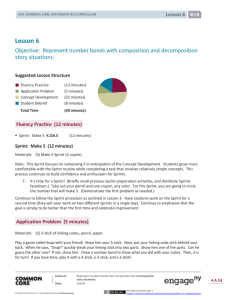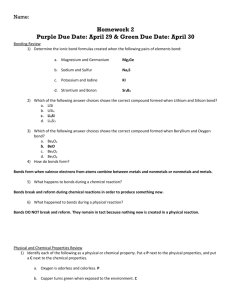
Lesson 4 K
NYS COMMON CORE MATHEMATICS CURRICULUM
Lesson 4
Objective: Represent decomposition story situations with drawings using
numeric number bonds.
Suggested Lesson Structure
Fluency Practice
Application Problem
Concept Development
Student Debrief
Total Time
(12 minutes)
(5 minutes)
(25 minutes)
(8 minutes)
(50 minutes)
Fluency Practice (12 minutes)
Comparing Towers K.MD.2
(5 minutes)
Show Me Part or Whole K.OA.1
(3 minutes)
Draw Lines to Make a Bond of 4 K.OA.1
(4 minutes)
Comparing Towers (5 minutes)
Materials: (S) Dice and 12 linking cubes per pair
Note: This fluency activity again relates length with number. It also encourages students to explore how
many more cubes are needed to make the towers the same length and number.
Each partner rolls a die and creates a tower using the number shown on the die. Students compare towers
and make a less than, more than, or same as statement. Then, the students must add cubes to the shorter
tower so it is the same height as the longer tower. Consider providing cubes of different colors so students
can easily count how many more cubes they added to make the towers the same length.
Show Me Part or Whole (3 minutes)
Materials: (T) Familiar objects that exemplify the part–whole relationship such as a whole apple and an
apple slice or a whole banana and a banana peel
Note: This activity prepares students for today’s lesson by linking mathematical vocabulary to kinesthetic
movement and associating part-whole relationships with familiar objects.
T:
S:
Show me the sign for whole. (Model two hands clasped together.)
(Hold two hands clasped together.)
Lesson 4:
Date:
© 2014 Common Core, Inc. Some rights reserved. commoncore.org
Represent decomposition story situations with drawings using
numeric number bonds.
2/9/16
This work is licensed under a
Creative Commons Attribution-NonCommercial-ShareAlike 3.0 Unported License.
4.A.36
Lesson 4 K
NYS COMMON CORE MATHEMATICS CURRICULUM
T:
S:
T:
S:
T:
S:
T:
S:
T:
S:
T:
S:
T:
S:
T:
S:
Let’s use our math muscles and take it apart (exaggerate with facial expression, as if straining to pull
the two hands apart).
(Pull two hands apart.)
Show me whole.
(Hold two hands clasped together.)
Show me parts.
(Pull two hands apart.)
Whole, part, whole, part, part, part, whole, whole, part…
(Show hand gestures as indicated.)
Now, I’ll show you some objects, and I want you to decide if it’s the whole thing (reinforce with hand
gestures) or just part of something (emphasize with gesture). (Hold up an apple slice.) Is this the
whole apple or part of the apple? Think. (Pause.) Now, show me.
(Hold hands apart, as before.)
Now tell me. Is it whole (gesture) or part (gesture)?
Part!
Very good. Look at what I have now. (Show a whole apple.) Whole or part? Think. (Pause.) Now,
show me.
(Clasp hands together to indicate whole.)
Raise your hand when you know the math word. (Wait for all hands to go up, and then signal.)
Whole!
Repeat with a few more objects, being careful to avoid a
predictable pattern. Increase the pace, and reduce
scaffolding as students demonstrate mastery.
Draw Lines to Make a Bond of 4 (4 minutes)
Materials: (S) 4 beans, make a bond of 4 (Fluency
Template) inserted into personal white board
Note: This fluency activity reinforces the part–total
relationship represented by the number bond. It helps
students understand that the lines of the number bond
connect the two parts with the total and that the
orientation of the parts and total do not affect the
numerical relationship.
Conduct activity as outlined in Lesson 2. As a variation,
have students write the numerals into the parts and
wholes (on top of the dots), and then state the
decomposition (e.g., 4 is 2 and 2).
Lesson 4:
Date:
© 2014 Common Core, Inc. Some rights reserved. commoncore.org
Represent decomposition story situations with drawings using
numeric number bonds.
2/9/16
This work is licensed under a
Creative Commons Attribution-NonCommercial-ShareAlike 3.0 Unported License.
4.A.37
Lesson 4 K
NYS COMMON CORE MATHEMATICS CURRICULUM
Application Problem (5 minutes)
Materials: (S) Small piece of clay, paper, pencil
NOTES ON
MULTIPLE MEANS
OF ENGAGEMENT:
Anthony had 5 bananas. Make the 5 bananas with your clay.
He wanted to share the bananas with one of his friends. Draw
two plates on your paper. Put the bananas on the plates to
show one way he could share the bananas with his friend. Draw
a number bond to show how he shared his 5 bananas.
Turn and talk with your partner. Did she do it the same way?
How many different ways can you find to share the bananas?
What if there were only 4 bananas?
Note: The Application Problem encourages students to explore
different configurations of 5 in preparation for today’s lesson on
decomposition.
Chunk the Application Problem into
small pieces for students with
disabilities. Give a direction, and then
watch as the students carry it out
before moving on with the next one.
For example, “Make 5 bananas with
your clay. (Pause.) Draw two plates
on your paper. (Pause.) Put the
bananas on the plates to show one
way to share the bananas.”
Concept Development (25 minutes)
Materials: (S) Number bond (Lesson 1 Template 2), two linking cube 5-sticks (all of the same color), personal
white board
Ensure that student templates are oriented with the whole on the top and the parts on the bottom.
T:
T:
T:
MP.2
T:
S:
T:
Let’s pretend today! Pretend that you have 5 apples.
Show me with your cubes how the group of 5 apples
A NOTE ON
would look on your mat.
MULTIPLE MEANS
I’m going to draw the linking cubes into this number
OF ACTION AND
bond on the board, just like you put them in your
EXPRESSION:
whole.
Using cubes of one color to represent
Now, pretend that 3 of your apples are red and 2 are
the apples pushes students to think
green. Show with your other set of cubes how that
abstractly about the problem. If it is
would look on your mat.
necessary to start with different color
cubes to support a student who is
Good! I’ll draw those cubes in the number bond, too.
struggling with decomposition, do so,
Look carefully at your groups of cubes. Let’s show how
but repeat the problem with cubes of
they would look in the number bond if we used
one color to help the student move
numbers instead. Take your cubes off and write the
toward more abstract thinking.
numbers with your marker as we have done before.
Who would like to tell me how to fill in our numbers?
The 5 is in this circle, in the whole. I put the 2 in this part and the 3 in the other part.
Great job! You separated the 5 cubes as a set of 2 cubes and a set of 3 cubes. 5 is the same as 2 and
3 together. Did anyone do it a different way? (Allow time for discussion.)
Lesson 4:
Date:
© 2014 Common Core, Inc. Some rights reserved. commoncore.org
Represent decomposition story situations with drawings using
numeric number bonds.
2/9/16
This work is licensed under a
Creative Commons Attribution-NonCommercial-ShareAlike 3.0 Unported License.
4.A.38
Lesson 4 K
NYS COMMON CORE MATHEMATICS CURRICULUM
T:
T:
S:
T:
S:
T:
Put your cubes away. Let’s make a different number bond. This time, I want to pretend I have 4
balls. 1 is blue, and 3 are orange. How could I show this in my number bond picture? (Allow
students to guide you in creating the pictorial number bond.) Make this number bond picture on
your mat, too.
Now, erase the pictures in your number bond and
write the numbers instead. Did we change our story?
A NOTE ON
No! We just wrote it in a different way.
MULTIPLE MEANS
Let’s make another story about 3 things. Let’s draw 3
OF ACTION AND
circles for 3 things in the place for our whole. Does
EXPRESSION:
anyone have an idea for a story that could give us the
Encourage English language learners
parts of a number bond for this 3?
to reach for experiences from their
culture to tell a story about their
I have 3 toy cars. 1 is red, and 2 are blue.
number bond. Use the students’ prior
Hmmm… 1 red car and 2 blue cars. How would I show
knowledge to encourage them to
that in the number bond? (Allow time for discussion
participate in class and use the
and creation of the new pictorial number bond.) Now,
language they are learning.
show me how it would look with numbers instead.
Hold up your boards!
Repeat the exercise several times with wholes of 3, 4, and 5. This time, encourage students to only use
numbers in the bonds.
Sample further decomposition stories:
4 rabbits were hopping through the forest. When they heard a noise, 1 went under a tree, and 3
found a little cave to hide in.
Marta’s father bought 5 bananas. 2 were eaten on Monday, and 3 were eaten on Tuesday.
Mama robin had 3 eggs. 2 eggs hatched in the morning. 1 egg hatched in the afternoon.
T: Let’s do some more of this in our Problem Sets.
Problem Set (10 minutes)
Students should do their personal best to complete the Problem Set within the allotted time.
Student Debrief (8 minutes)
Lesson Objective: Represent decomposition story situations with drawings using numeric number bonds.
The Student Debrief is intended to invite reflection and active processing of the total lesson experience.
Invite students to review their solutions for the Problem Set. They should check work by comparing answers
with a partner before going over answers as a class. Look for misconceptions or misunderstandings that can
be addressed in the Debrief. Guide students in a conversation to debrief the Problem Set and process the
lesson.
Lesson 4:
Date:
© 2014 Common Core, Inc. Some rights reserved. commoncore.org
Represent decomposition story situations with drawings using
numeric number bonds.
2/9/16
This work is licensed under a
Creative Commons Attribution-NonCommercial-ShareAlike 3.0 Unported License.
4.A.39
Lesson 4 K
NYS COMMON CORE MATHEMATICS CURRICULUM
Any combination of the questions below may be used to lead the discussion.
Share with your neighbor the number bond you
drew on your Problem Set. How are they the
same? How are they different?
Yesterday, we started with the parts and found
the whole. When we started with the parts, could
we figure out what the whole had to be?
Today, we started with the whole and found the
parts. When we start with the whole, can we
figure out what the parts have to be, or do we
need to be told more of the story? If we just know
the whole, can we still figure out what the parts in
our story might be?
When we start with the whole, it makes sense to
me to put the whole on top so it’s as if the parts
are falling down. When we start with the parts, I
like to put them on top. Then, it’s as if they are
falling down and landing in the same spot. It
doesn’t have to be like that, but do you
understand my thinking? Can you explain my
thinking to your partner? (It is also valid to think
of the story progressing from left to right.
Explaining this orientation supports the pattern of
reading text from left to right.)
When you drew your bananas in the number
bond, did your number bond look exactly like your
partner’s? How were they different? (Focus in on
orientation of the number bond.) Does it really
matter where we put the parts and the whole?
How do we know where to write each number in a
number bond?
Lesson 4:
Date:
© 2014 Common Core, Inc. Some rights reserved. commoncore.org
Represent decomposition story situations with drawings using
numeric number bonds.
2/9/16
This work is licensed under a
Creative Commons Attribution-NonCommercial-ShareAlike 3.0 Unported License.
4.A.40
NYS COMMON CORE MATHEMATICS CURRICULUM
Name
Lesson 4 Problem Set K
Date _____________
Draw and write the numbers to complete the number bonds.
5
Lesson 4:
Date:
© 2014 Common Core, Inc. Some rights reserved. commoncore.org
Represent decomposition story situations with drawings using
numeric number bonds.
2/9/16
This work is licensed under a
Creative Commons Attribution-NonCommercial-ShareAlike 3.0 Unported License.
4.A.41
NYS COMMON CORE MATHEMATICS CURRICULUM
Lesson 4 Problem Set K
Look at the picture. Tell your neighbor a story about the dogs standing
and sitting. Draw a number bond and write numbers that match your story.
Lesson 4:
Date:
© 2014 Common Core, Inc. Some rights reserved. commoncore.org
Represent decomposition story situations with drawings using
numeric number bonds.
2/9/16
This work is licensed under a
Creative Commons Attribution-NonCommercial-ShareAlike 3.0 Unported License.
4.A.42
Lesson 4 Homework K
NYS COMMON CORE MATHEMATICS CURRICULUM
Name
Date
Finish the number bonds. Finish the sentence.
3
is
and
111
2
4
is
and
Tell an adult a story about the
animals, and then make a number
sentence and number bond about it.
is
and
Lesson 4:
Date:
© 2014 Common Core, Inc. Some rights reserved. commoncore.org
Represent decomposition story situations with drawings using
numeric number bonds.
2/9/16
This work is licensed under a
Creative Commons Attribution-NonCommercial-ShareAlike 3.0 Unported License.
4.A.43
NYS COMMON CORE MATHEMATICS CURRICULUM
Lesson 4 Fluency Template K
Draw lines to make a bond of 4.
make a bond of 4
Lesson 4:
Date:
© 2014 Common Core, Inc. Some rights reserved. commoncore.org
Represent decomposition story situations with drawings using
numeric number bonds.
2/9/16
This work is licensed under a
Creative Commons Attribution-NonCommercial-ShareAlike 3.0 Unported License.
4.A.44









